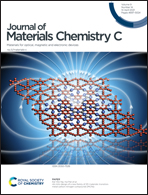Engineering donor–acceptor conjugated polymers for high-performance and fast-response organic electrochemical transistors†
Abstract
To date, high-performance organic electrochemical transistors (OECTs) have mostly been based on polythiophene systems. Donor–acceptor (D–A) conjugated polymers are expected to be promising materials for OECTs owing to their high mobility and comparatively low crystallinity (good for ion diffusion). However, the OECT performance of D–A polymers lags far behind that of the polythiophenes. Here we synergistically engineered the backbone and side chain of a series of diketopyrrolopyrrole (DPP)-based D–A polymers and found that redox potential, molecular weight, solution processability, and film microstructures all have a severe impact on their performance. After systematic engineering, P(bgDPP-MeOT2) exhibited the best figure-of-merit (μC*) of 225 F cm−1 V−1 s−1, amongst the highest performance of the reported D–A polymers. Besides, the DPP polymers exhibited high hole mobility of over 1.6 cm2 V−1 s−1, leading to fast response OECTs with a record low turn-off response time of 30 μs. The polymer also exhibited good operation stability with a current retention of 98.8% over 700 electrochemical switching cycles. This work reveals the complexity and systematicness in the development of D–A polymer based high-performance OECTs.



 Please wait while we load your content...
Please wait while we load your content...